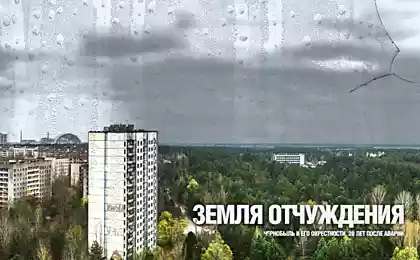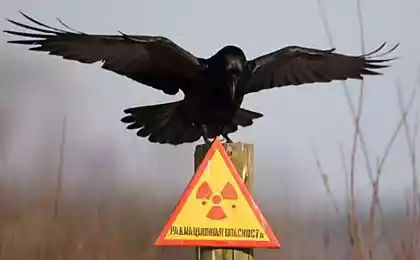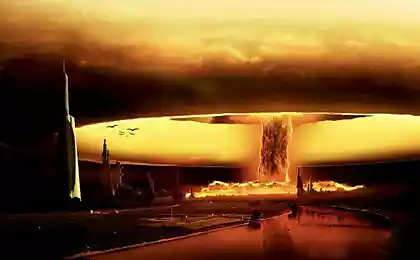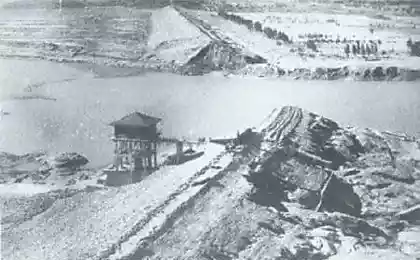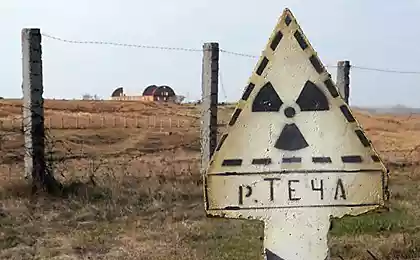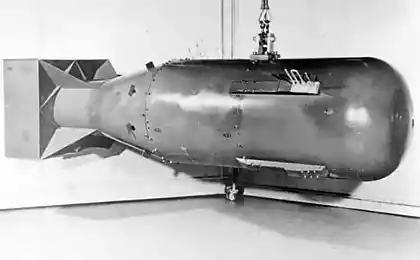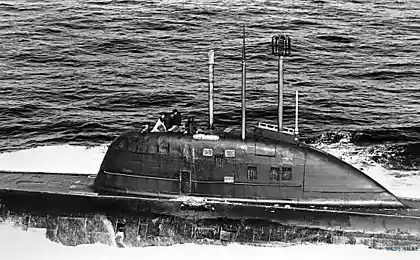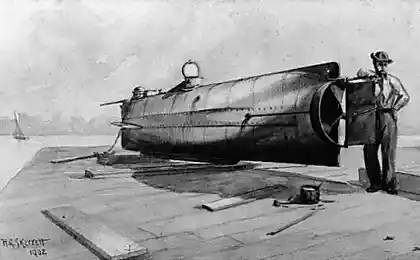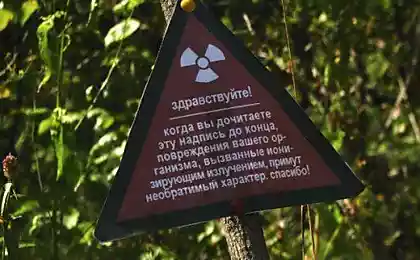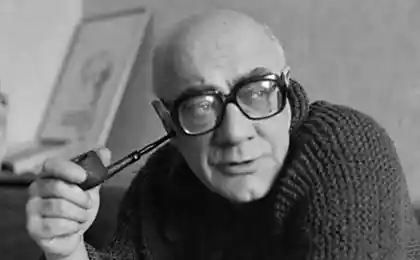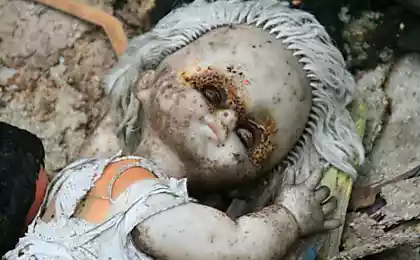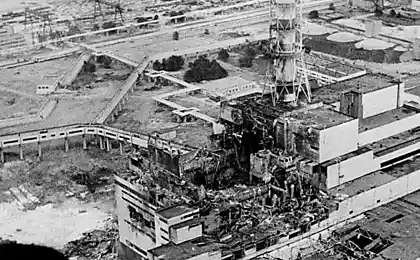8965
The most terrible nuclear disaster in the history of mankind (72 photos)
The explosion at the Chernobyl nuclear power plant occurred at 1:23 am April 26, 1986, resulting in a radioactive cloud that enveloped much of Europe. According to experts, the victims of the accident consequences steel from 15,000 to 30,000 people. More than 2, 5 million Ukrainians have health problems related to the Chernobyl accident, about 80,000 receive pensions.
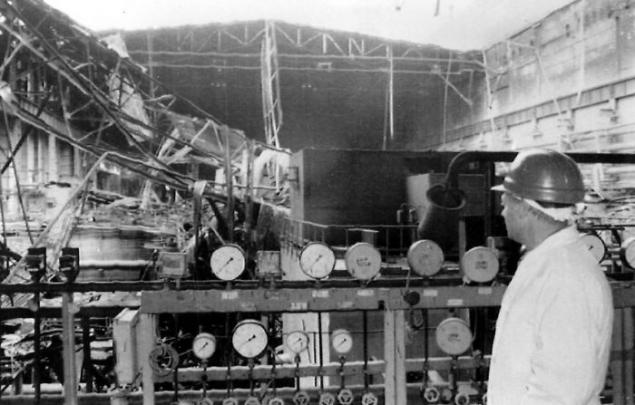
Engineer studying the fracture in the control room reactor at the Chernobyl nuclear power plant, 13 October 1986, on the Sunday after the incident on Friday fire, which destroyed the roof. This is the second accident occurred a year after the April 26, 1986 accident. Environmentalists demanded an immediate shutdown of the reactor and the closure of the station.
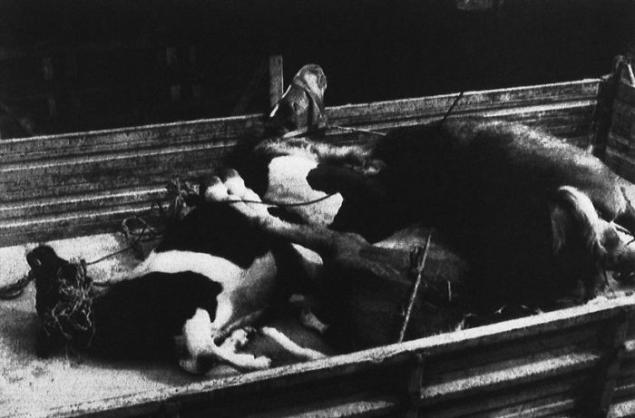
Four of the thirty cows died during a stop at a checkpoint in Pontebba on the Italian-Austrian border lie in freight cars in Pontebba, Italy, Tuesday, May 7, 1986. Cows were sent back to Poland after the check has revealed that the animals are victims of radiation contamination as a result of the accident at the Chernobyl nuclear power plant in the Soviet Union.
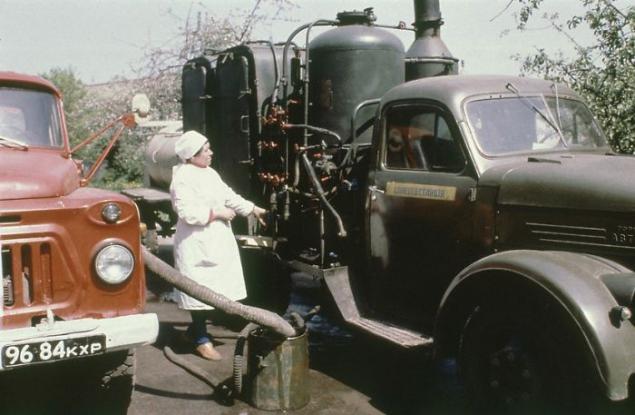
Soviet art May 9, 1986 in Kiev prepare the tank with a special solution for decontamination of people exposed to radiation, as well as their clothing and equipment after the accident at the Chernobyl nuclear power plant.
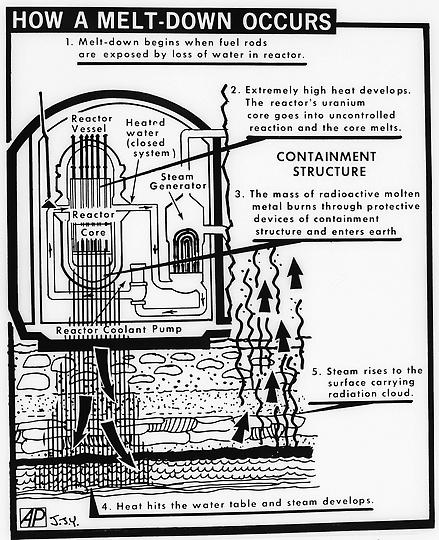
May 9, 1986, Friday. A graph showing the melting process of nuclear fuel. It is believed that molten fuel could hardly get into ground water, even under the condition that it has passed through the reactor floor. So according to US nuclear engineers.
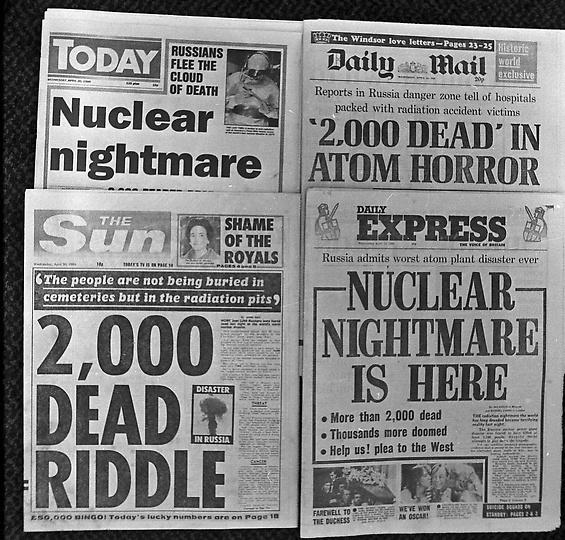
This editorial Morning Edition four British newspapers that tell about the accident at the Chernobyl nuclear power plant in Ukraine, the Soviet Union.
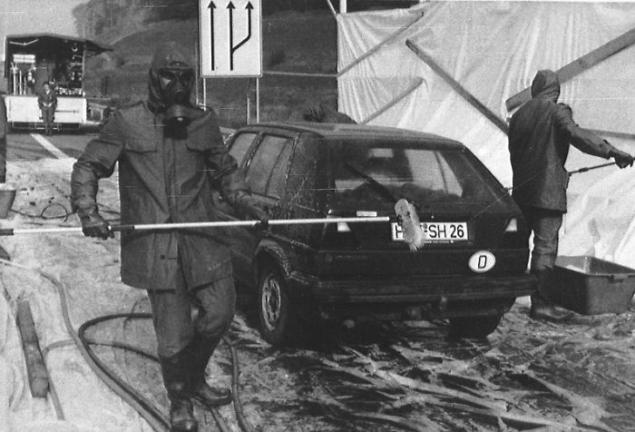
Firefighters in protective suits wash machine from West Germany about Herleshausen on the border with East Germany, May 3, 1986, after this car came from Poland, so that was contaminated by radiation after the Chernobyl nuclear power plant.
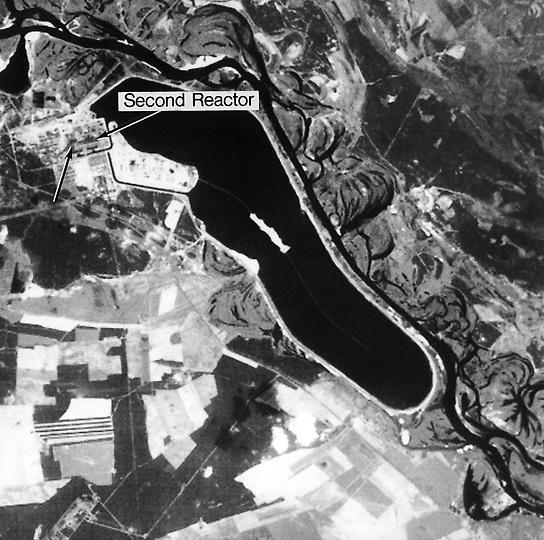
April 29, 1986. Photo Chernobyl nuclear power plant made by satellite «Landsat 5". Water object in the center of the photo - a cooling pool.
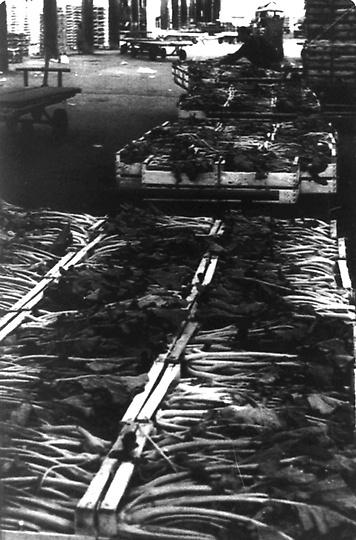
Boxes with unsold fresh fruit and vegetables in the vegetable market in Milan, May 3, 1986. After the accident at the Chernobyl nuclear power plant in the Soviet Union health ministry has banned the use of raw milk and fruit. This prohibition has acted throughout Italy for two weeks as a precaution; Nevertheless, trucks with vegetables and fruits continued as usual to arrive in Milan, although markets were closed for visitors.

Dutch truck arrived from Eastern Europe wash decontamination solution fire after his arrival at Herleshausen on the border with East Germany, Friday, May 3, 1986. Just this day was made disinfection ten trucks. The rest were sent back.
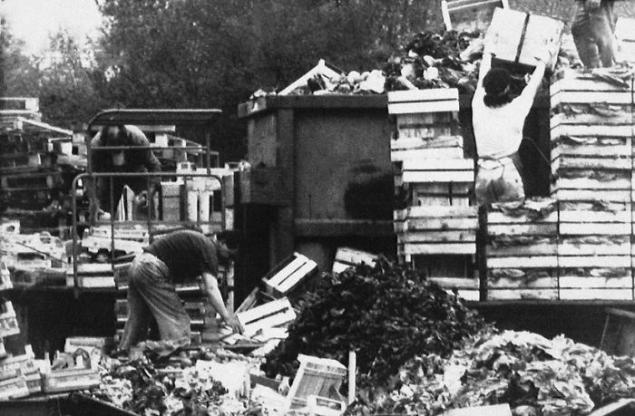
Employees of the grocery market in Milan, the largest of all the product markets in Italy and one of the biggest in Europe, carried out the destruction of fresh fruits and vegetables, which arrived in Italy on Saturday, May 3, 1986, fear of radioactive contamination as a result of the accident at the Chernobyl nuclear power station in the Soviet Union. After the accident, the Ministry of Health has banned the use of raw milk and fruit.

May 5, 1986. Although the Ministry of Health officials in West Germany warned farmers about the need to keep the cattle in sheds locked after the accident at the Chernobyl nuclear power plant in the Soviet Union, many have ignored this warning. This cow from Mikelshtadt, West Germany may have undergone radiation pollution.
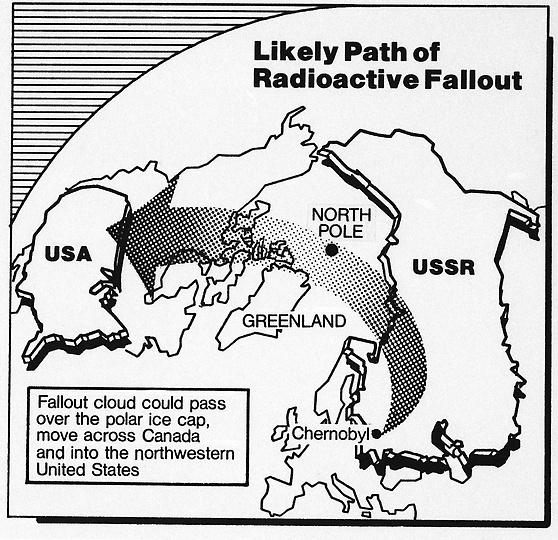
April 29, 1986. Experts say that the radioactive cloud after the accident at the Chernobyl nuclear power plant in the Soviet Union, it is possible to reach the Arctic Circle, will be held over Canada and the northwestern United States. However, as stated, the radiation dose is too small to cause serious harm to human health.

Young people from West Berlin pours milk from cartons May 11, 1986 to protest against the possible radioactive contamination of milk and other food products. Increasing the level of radiation in food was observed in Berlin after the accident at the Chernobyl nuclear power plant in the Soviet Union. The inscription on the banner reads: "may cause poisoning».

Iodine solution was used as a possible resistance to radiation contamination. The nurse enters his three year old girl is holding her mother, the child health clinic in Warsaw, April 30, 1986.

Wednesday, May 1, 1986. 64 passengers arrived on board a special flight Austrian Airlines from Minsk, Soviet Union. All they have to pass control of the level of radiation exposure, barely leaving the plane at the airport in Vienna. Most of the passengers were relatives of the Austrians, who worked in the Soviet Union, however, journalists claimed that among them were 20 Germans.
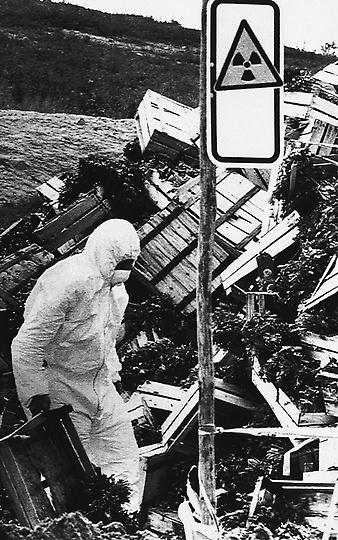
May 7, 1986. Under the sign warning about radiation, scavenger in West Berlin puts boxes with fruits and vegetables that may have been infected. After the accident, the Ministry of Health has banned the use of raw milk and fruit.

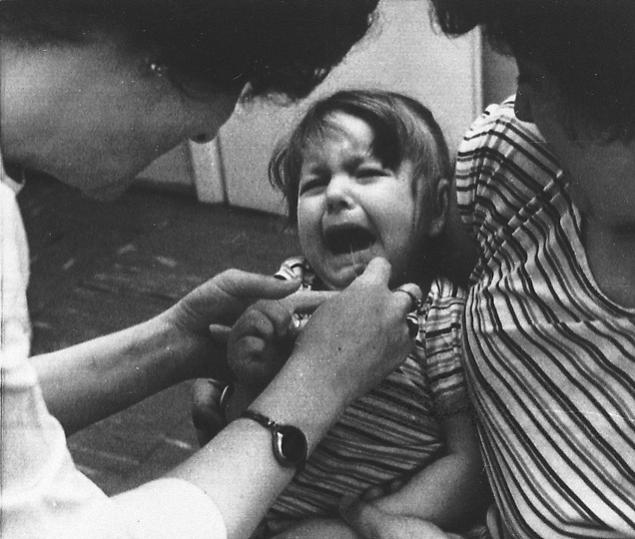
Iodine solution as a possible counter radiation pollution, introduced three year old girl is holding her mother, the child health clinic in Warsaw, April 30, 1986.
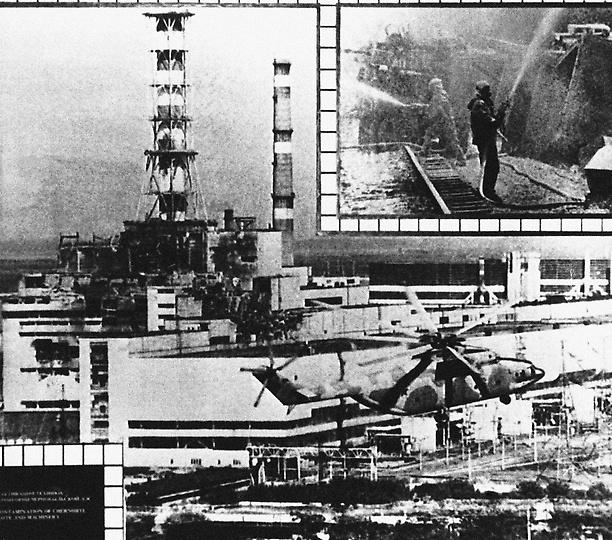
Vienna, Austria, August 25, 1996. Nuclear experts from the International Agency for the control of atomic energy at the opening of the five-day meeting on the accident at the Chernobyl nuclear power plant in the Soviet Union. The photograph - Chernobyl Nuclear and firefighters at work.
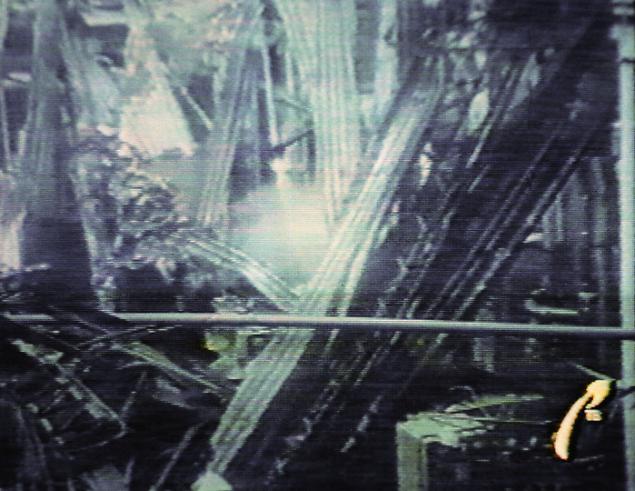
Picture of the collapsed roof of the Chernobyl nuclear damaged in a fire. Russian television broadcast on October 12, 1991, Moscow. The fire occurred on the eve of Friday.
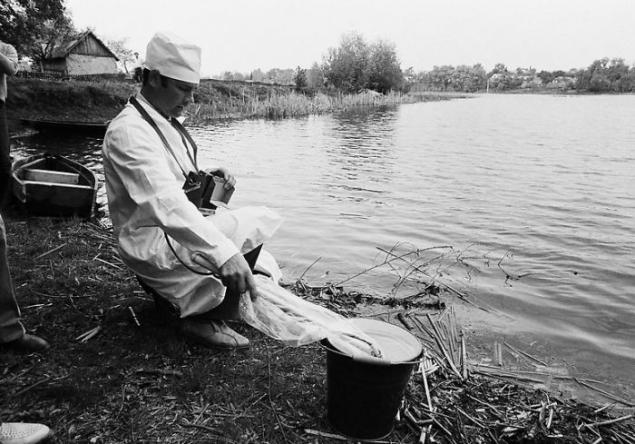
Check for radioactive contamination of water, typed in the creek near Kiev, May 9, 1986.. Checks were carried out every hour after the accident at the Chernobyl nuclear power plant in the Soviet Union.
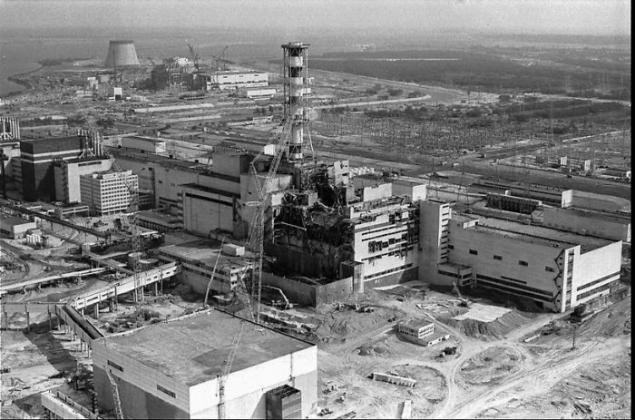
1986. Aerial view of the Chernobyl nuclear power plant in the Soviet Union. Clearly visible destruction caused by the explosion of the fourth reactor April 26, 1986, as a result of which there was a release of radioactive material into the atmosphere. Ten years after the accident, the station still continued its work due to the acute shortage of electricity in Ukraine.

The photo was taken from a helicopter. Aerial view of the Chernobyl nuclear power plant, in particular, on the fourth unit, the explosion which occurred April 26, 1986. The fire lasted for 10 days, underwent radiation pollution Russia, Ukraine and Belarus. Promulgated in September Report of the International Health Organization announced that killed 4,000 people as a result of the accident, when in fact it is a much greater sacrifices. Ukraine claims that health problems after the accident began at 2, 4 million of its citizens, including 428,000 children have
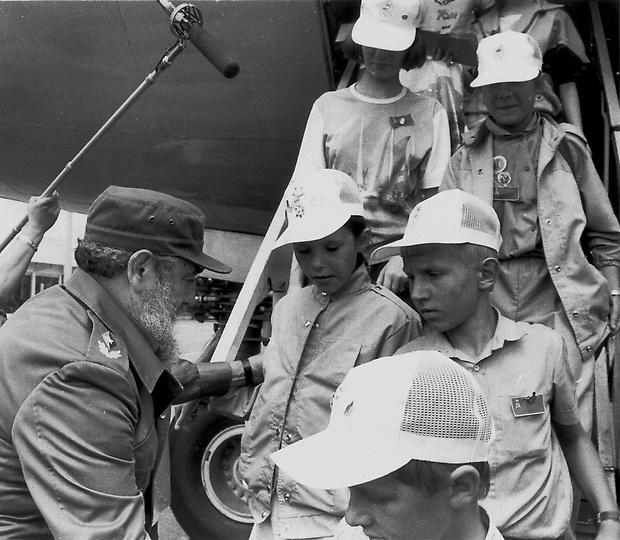
Cuban President Fidel Castro (left) takes a group of children from Belarus after the Chernobyl nuclear power plant at the international airport of Havana, July 2, 1990.
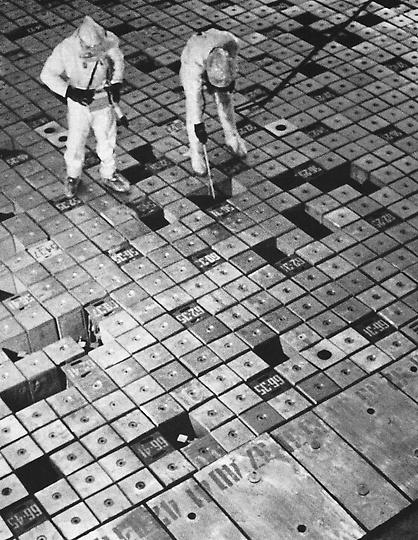
Photo from the February issue of the Soviet magazine «Life», where - the first unit of the Chernobyl nuclear power plant. The photo was taken April 29, 1986. The Soviet government recognized that the station suffered in the accident, but the details were not specified.
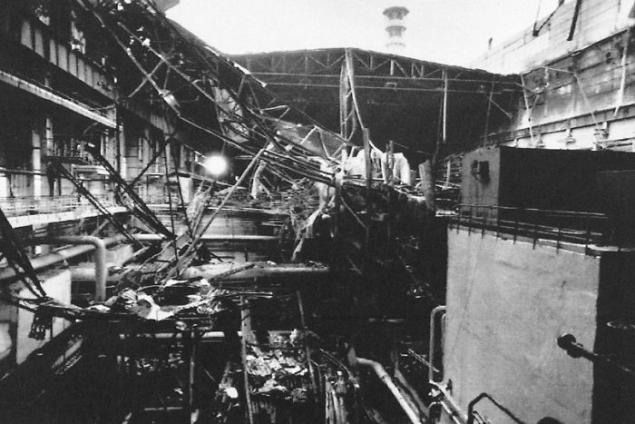
Part of the collapsed roof of the Chernobyl nuclear power plant, which suffered a fire. The photo was taken on Friday 13th October 1991, during a visit by members of the media on the subject. On Sunday, the station has been reactivated.
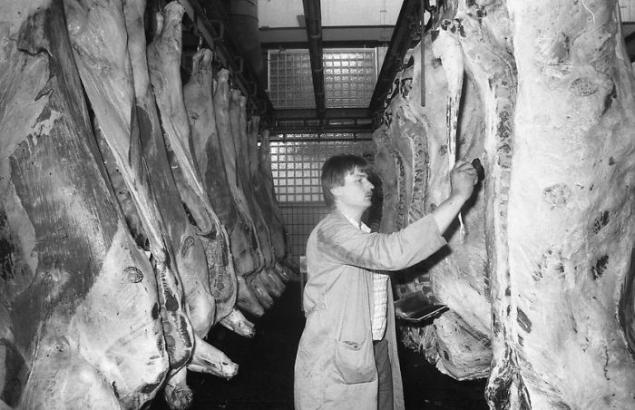
Worker puts printing on animal carcasses in a slaughterhouse in Frankfurt in West Germany, May 12, 1986, in a sign that the meat is fit for consumption and not contaminated with radiation. After the accident at the Chernobyl nuclear power plant was subjected to a similar check all the meat.
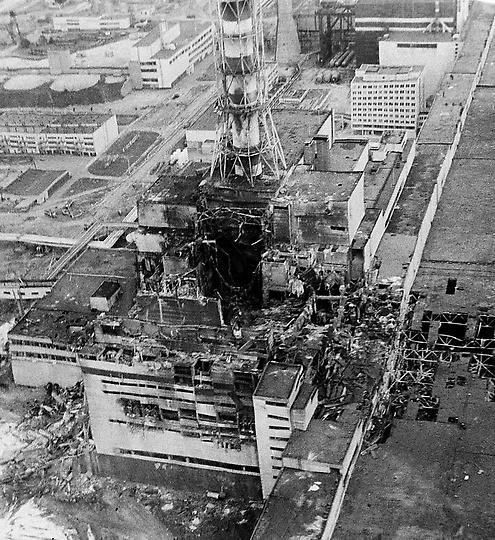
April 1986, a few days after the accident. Aerial view of the Chernobyl nuclear power plant.

May 9, 1986. Kiev residents tested for radioactive contamination after the accident at the Chernobyl nuclear power plant.
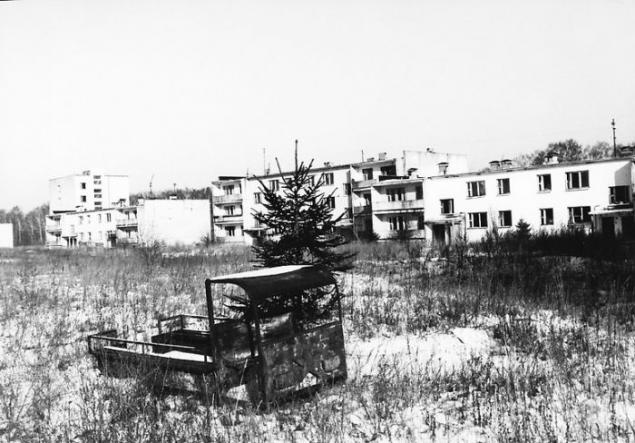
1992. Abandoned due to radioactive contamination village in the Gomel region.
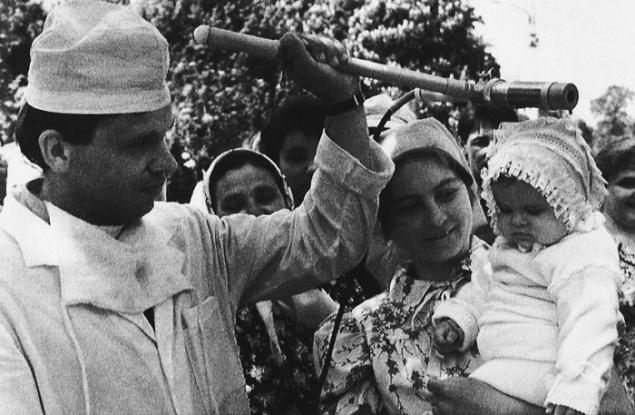
The population living near the Chernobyl nuclear station, check the level of radioactive contamination near Kiev on the farm Kopelovo, May 11, 1986. The photo was taken foreign photographers during the visit, which was organized for the foreign media, the Soviet government to demonstrate how to solve the problem arose.
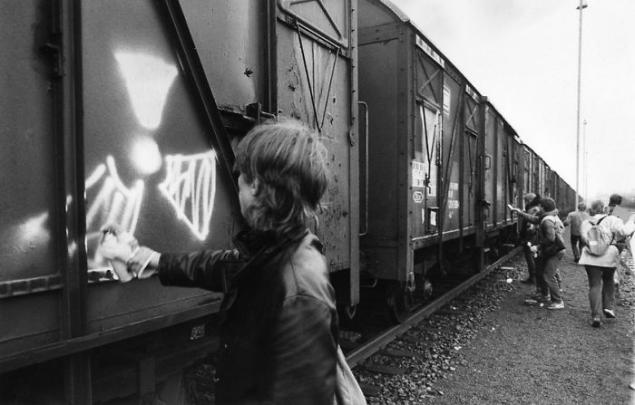
Bremen, northern Germany, February 6, 1987. Activists put the seal on cars with contaminated milk powder. Milk came to Bremen to be sent to Egypt. It was produced after the accident at the Chernobyl nuclear power plant.
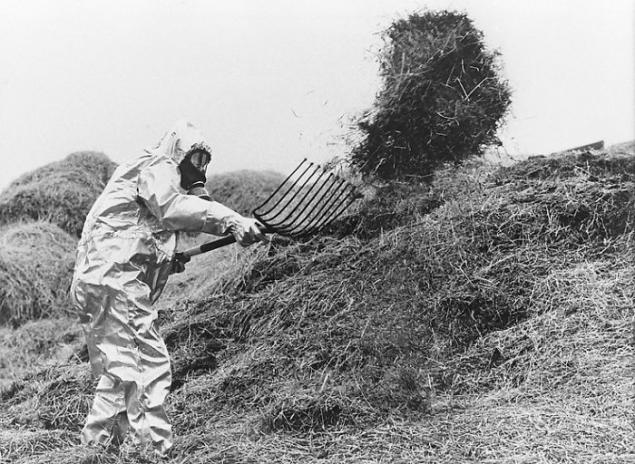
A few days have passed since the explosion of the fourth reactor. Swedish farmer in a protective suit destroys fodder, have been subjected to radiation contamination due to the accident at the Chernobyl nuclear power plant.
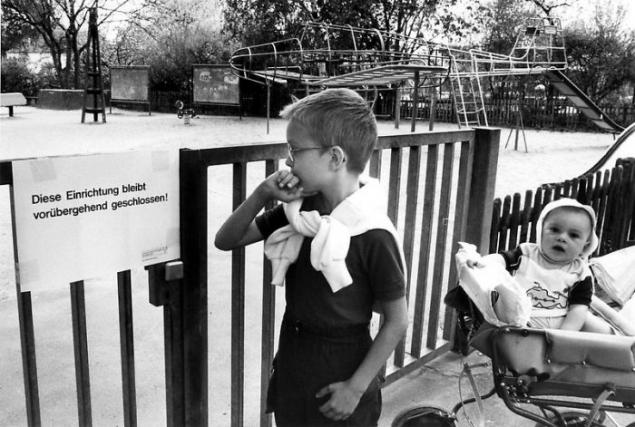
May 5, 1986, Wiesbaden. The boy looks at the locked gate attached to the children's playground classified "site is closed." All playgrounds have been closed by the decision of the city council a week after the accident at the Chernobyl nuclear power plant as a result of raising the level of radioactive contamination from 124 to 280 becquerels.

Chairman of the Presidium of the Supreme Soviet of the USSR Mikhail Gorbachev (center) and his wife Raisa Gorbachev (second from left) talking with officials at the Chernobyl nuclear power station February 23, 1989, during his first visit to the crash site.
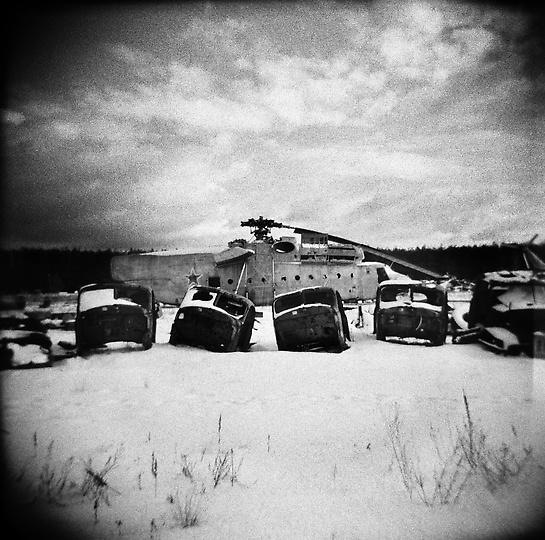
Having undergone radiation contamination during the liquidation of the accident at the Chernobyl nuclear power plant equipment, vehicles and helicopters are in the open air near the village of Staff, January 31, 2006. During the period from April 27 to May 5, more than 30 military helicopters took part in extinguishing the fire in the reactor. Total for suppression was used 2,400 tons of lead and 1,800 tons of sand. Tanks, helicopters and all the equipment, is run by the army of the Soviet Union and participated in extinguishing the fire, was left in the open air.
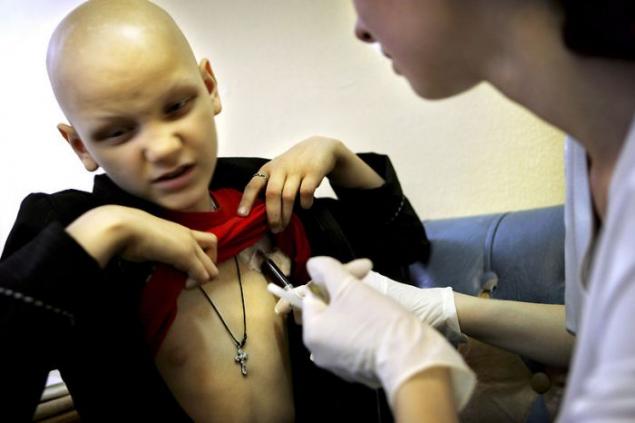
Children's Hospital in Kiev, Tuesday, April 18, 2006. Ukrainian doctor takes blood from a seven-year Mary Burlak, a cancer patient. According to the organization «Greenpeace» more 90,000 people died of cancer due to the accident at the Chernobyl nuclear power plant, contrary to the UN report, where the number of alleged victims is 4000. For detailed information on the health effects of the most serious accident of the twentieth century are still unavailable, although since disaster has passed twenty years.

Collapsed beams and shattered concrete pillars inside the sarcophagus over the fourth reactor of the Chernobyl nuclear power plant November 10, 2000. Geiger counter detects radiation levels inside the sarcophagus of 80,000 micro-roentgen per hour, 16,000 exceed natural levels.

Doll and mask covered with radioactive dust in an abandoned kindergarten in the ghost town of Pripyat, 10 March 2006, Ukraine. Pripyat town, located near the Chernobyl nuclear power station was built for the workstation. All the residents were evacuated for several hours after the accident, which occurred April 26, 1986. For two months after the accident, 29 people have died from the number of workers who took part in its liquidation.
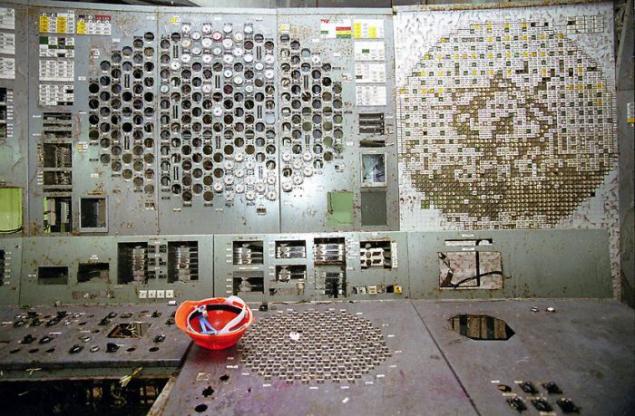
Photo by April 14, 1998. Control panel in the destroyed fourth block. 20 years since the disaster, which affected millions of people and the elimination of which went astronomical sums.
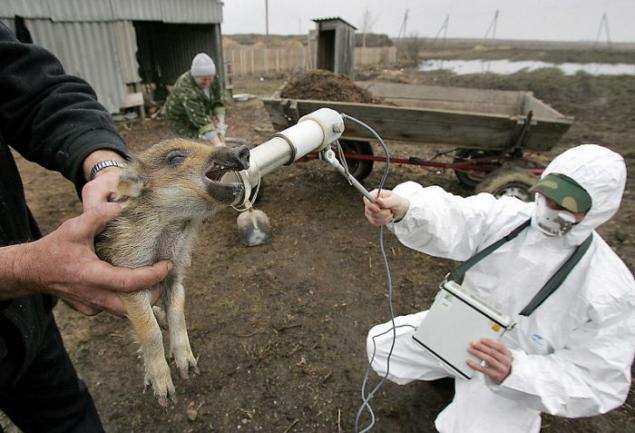
Measurement of radiation levels in the Belarusian village hoop on the territory of the 30 kilometer exclusion zone around the Chernobyl nuclear power plant. The fourth part of the territory of Belarus have been infected, and tens of thousands of people were evacuated in 1986 after an accident.
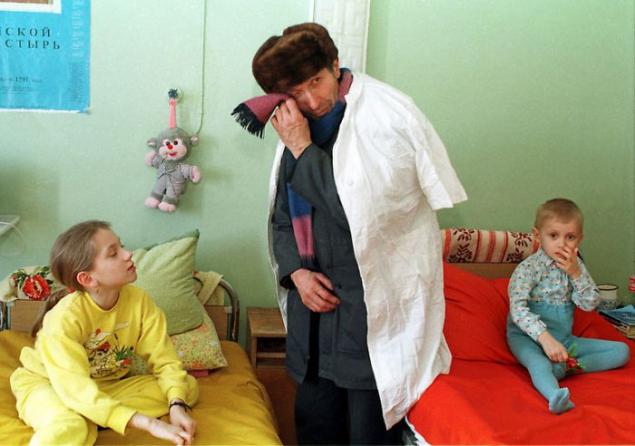
Ivan Kalenda wipes tears, visiting his three year old son Vitya, right, in oncological pediatric hospital in Gomel, 300 km south-west of Minsk, Belarus, March 19, 1996.
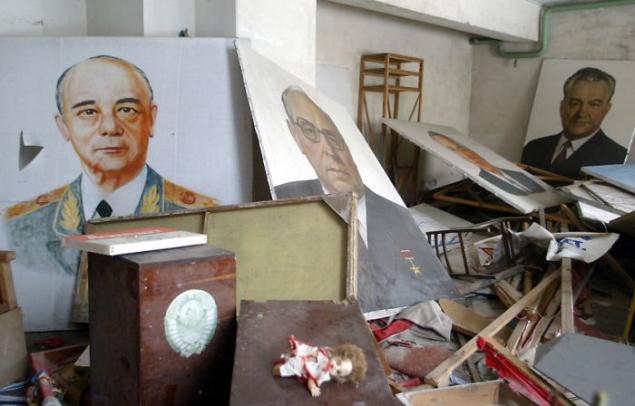
Covered with radioactive dust portraits of Soviet statesmen at the club in the ghost town of Pripyat, April 10, 2006. Portraits prepared for the May Day demonstration.
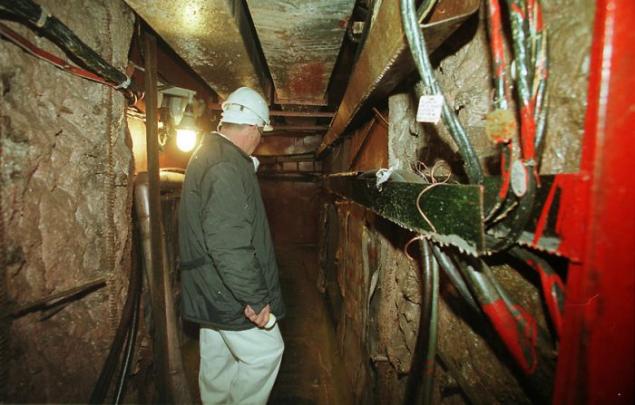
Dark transitions in the sarcophagus over the fourth power of the Chernobyl nuclear power plant.
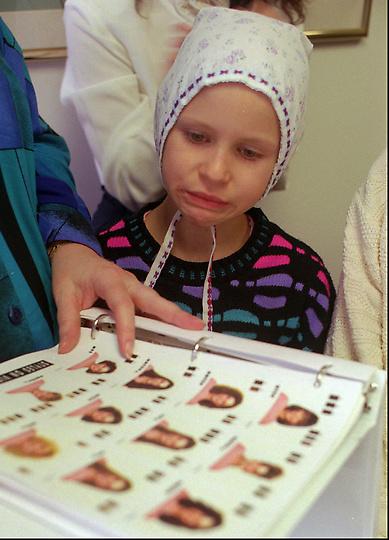
Seattle, Tuesday, Aug. 27, 1996. Eight-year Olga Osterozha of harmony, Belarus, choose a hairstyle in hairdressing album before transplanting hair follicles, which is part of the program of assistance to children affected by the accident at the Chernobyl nuclear power plant. Olga lost hair in the age of four. Olga and her sister Tanya, who eleven years old, living in a foster home near Seattle.
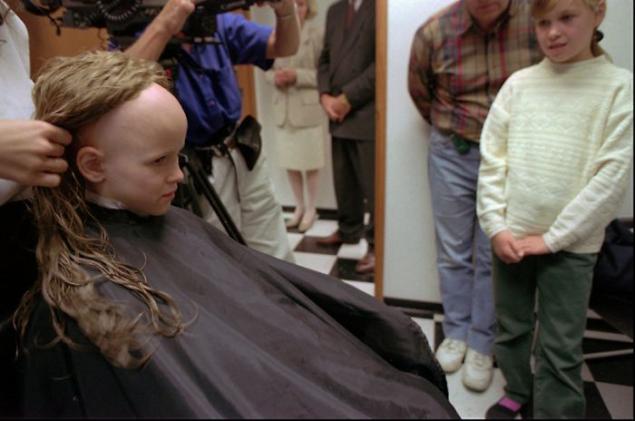
Eight-year Olga Osterozha of harmony, Belarus, watches as her sister implanted hair Tanya.
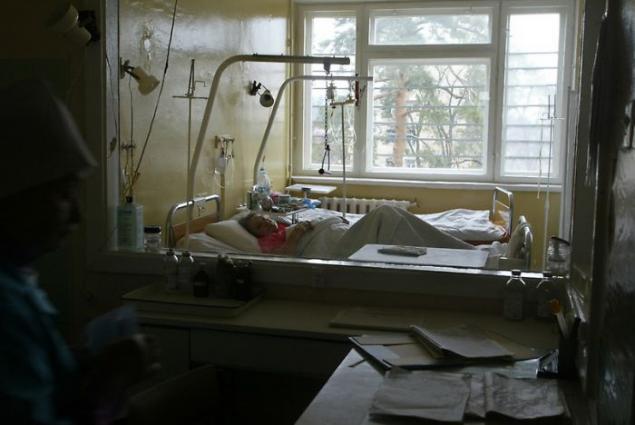
April 17, 2006. The patient at the Institute of Endocrinology, reanimation. The patient has gone through surgery for thyroid cancer. Thyroid cancer in Ukraine officially recognized consequence of the accident at the Chernobyl nuclear power plant.
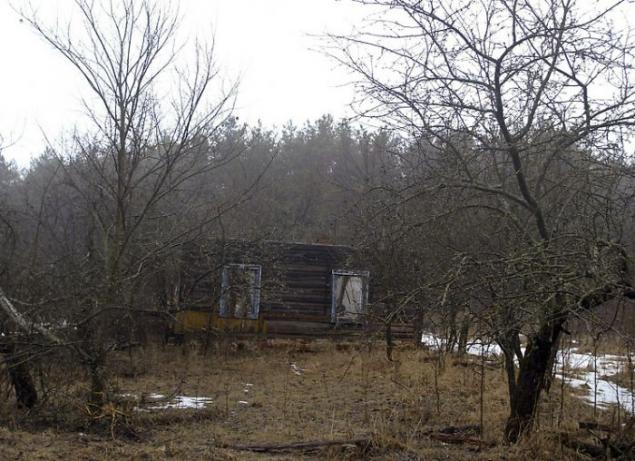
March 30, 2006. Abandoned house in the village ghost Redkovka 35 kilometers from the Chernobyl nuclear power plant. Despite the fact that most of the residents were evacuated after the accident at the Chernobyl nuclear power plant, some prefer to return to their old homes, explaining that they can not adapt to life in a new place.
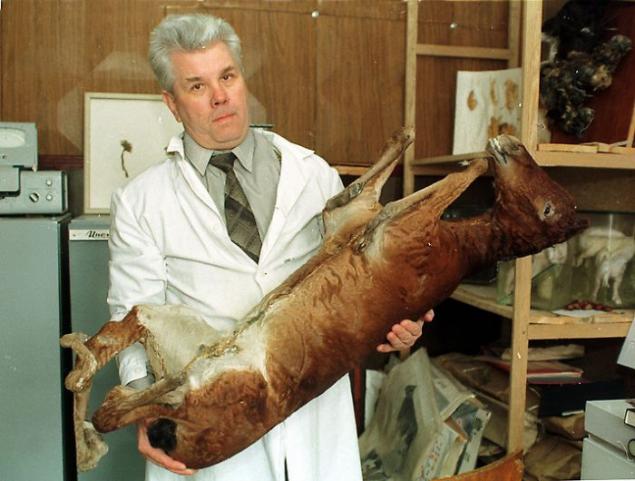
March 11, 1996. Professor of biological sciences Vyacheslav Konovalov, shows a stuffed mule mutant in his laboratory in Zhytomyr, about 120 kilometers west of Kiev. He collects the exposure of stuffed animals and plants-mutants. Professor - weirdo and has a lead protective apron under her clothes since the accident.
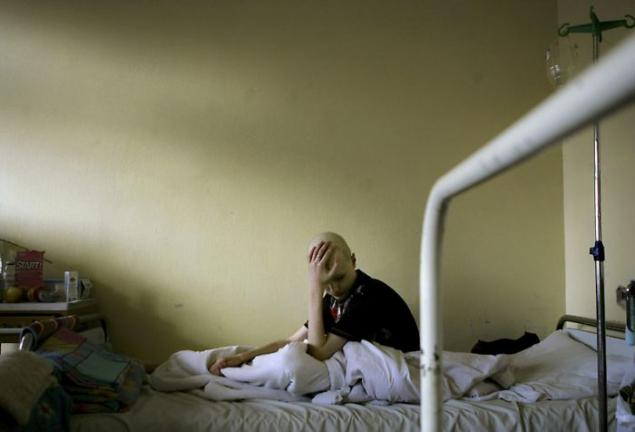
Seven Years Maria Bourlak with cancer in pediatric oncology hospital in Kiev, April 18, 2006.
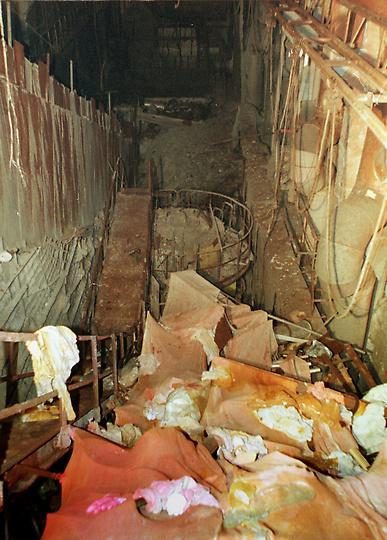
The fourth reactor of the Chernobyl nuclear power plant. Cured foam, lead and boron powder that helicopters dropping, trying to prevent a nuclear reaction. In the construction of the sarcophagus hastily radiation level reaches thousands of X-rays, and a deadly level - for 150 X-rays.
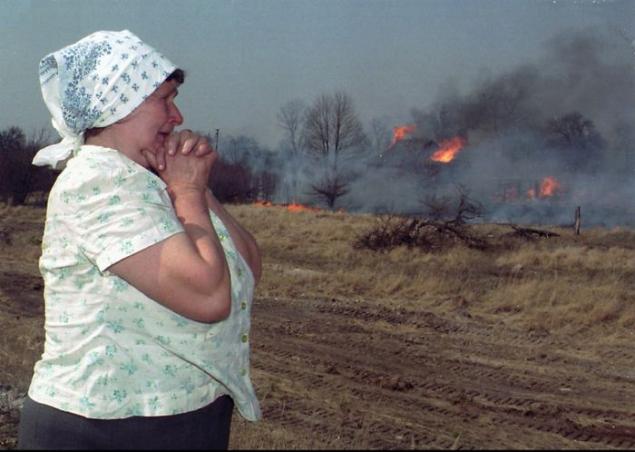
Tuesday, April 23, 1996. A woman looks at a fire in a small village town red ten kilometers from the Chernobyl nuclear power plant. Fire in five villages lasted seven hours and the atmosphere was thrown a huge amount of toxic substances.
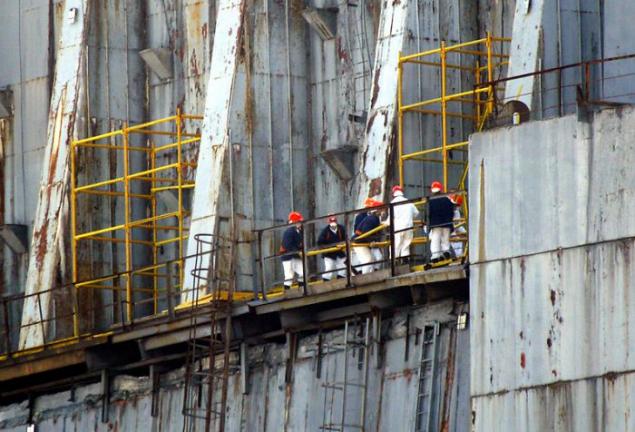
April 10, 2006. Constructors in protective masks and suits working to strengthen the crumbling sarcophagus over the fourth reactor of the Chernobyl nuclear power plant. Due to high levels of radiation workers work in shifts, and the change may last from four to fifteen minutes.
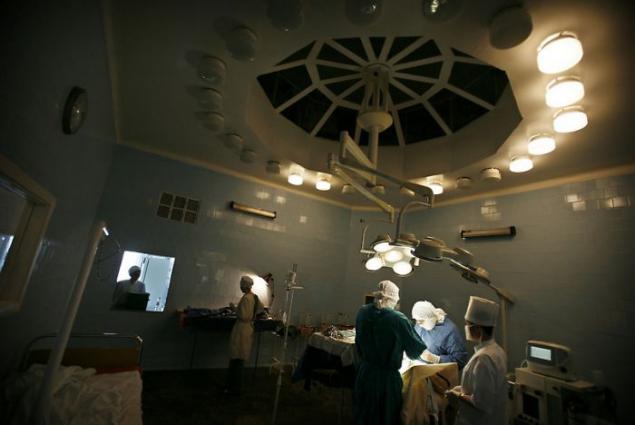
Surgery for thyroid cancer in the hospital Kiev, April 6, 2006. The incidence has increased rapidly since the accident at the Chernobyl nuclear power plant.
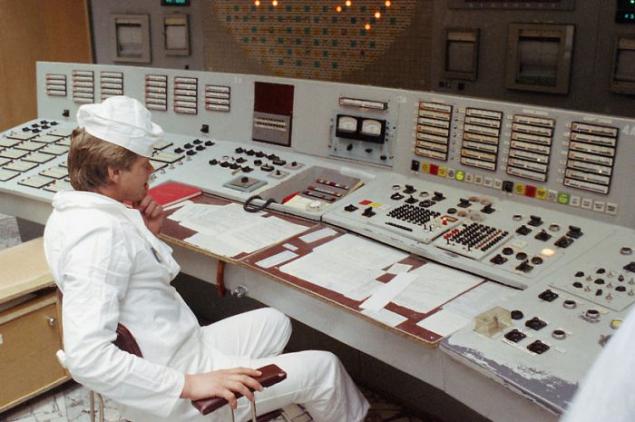
Pripyat, Ukraine, July 1988. Observation instrument readings, controlling operation of the reactor. In 1988, a reactor exploded and killed at least 31 people.
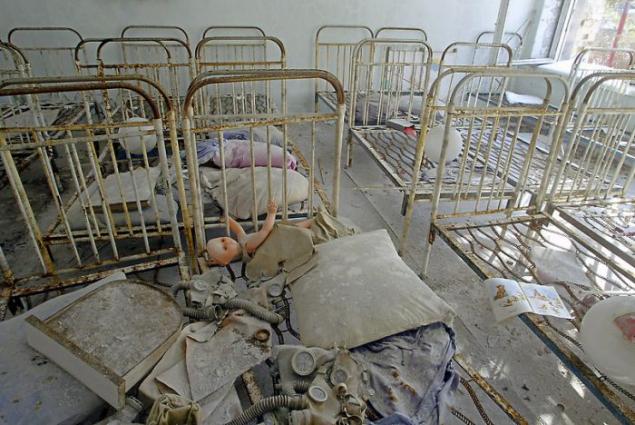
Toys and masks covered with radioactive dust in kindergarten in the ghost town of Pripyat, 10 March 2006.
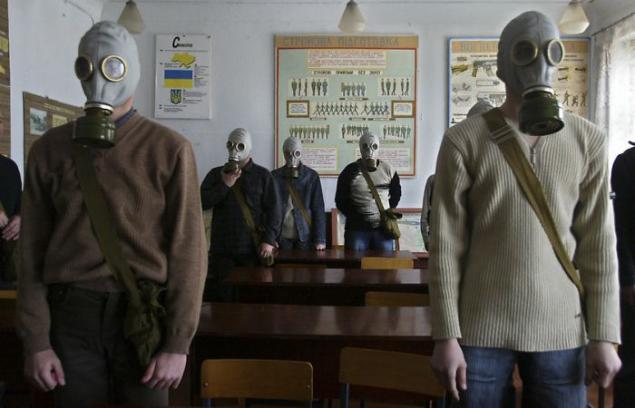
Pupils in gas masks during a lesson pre-conscription training in Rudo near the exclusion zone around the Chernobyl nuclear power plant, Monday, April 3, 2006.
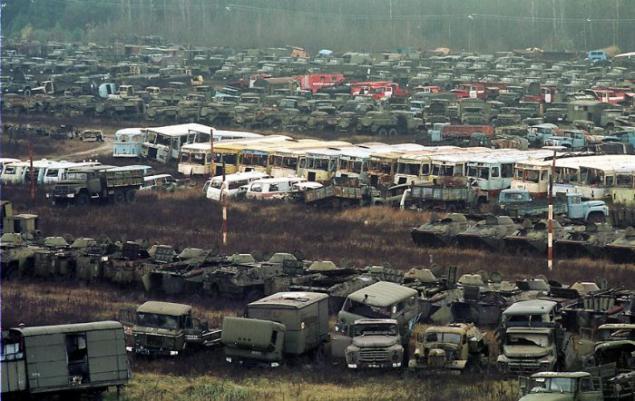
November 10, 2000. Contaminated equipment far from Chernobyl.

Saturday, February 18, 2006. Ivan and Elena Muzichenko for home use kerosene lamp - electricity in the village Bartolomeevka, located 330 km south-east of Minsk, no. Twenty years after the accident at the Chernobyl nuclear power plant in many abandoned villages in Belarus residents have returned - the government issued a decree that the black soil should not be left untreated, while the storm radiation contamination allegedly was artificially inflated.
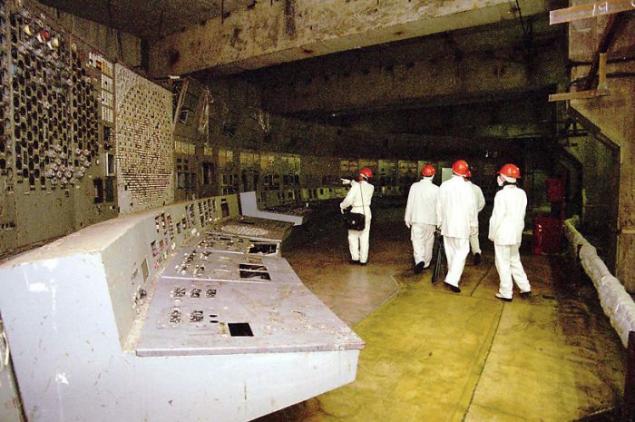
April 14, 1998. The workers of the Chernobyl nuclear power station pass by the control panel of the destroyed fourth block.
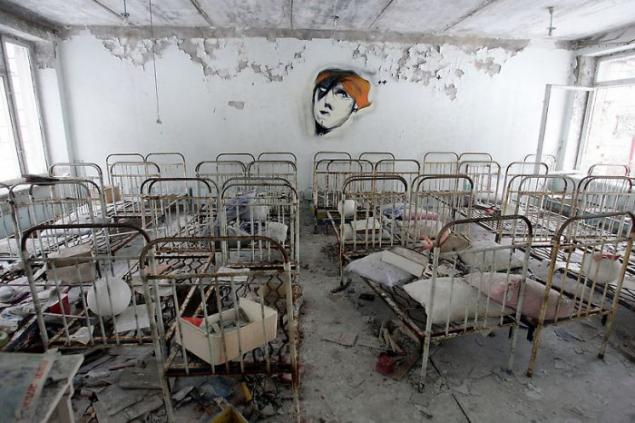
Bedroom in a kindergarten ghost town of Pripyat, 27 February 2006.

Children ride in a ghost town of Pripyat, photo taken May 26, 2003. All the city had 45,000 residents who were evacuated in the first three days after the accident at the Chernobyl nuclear power plant.
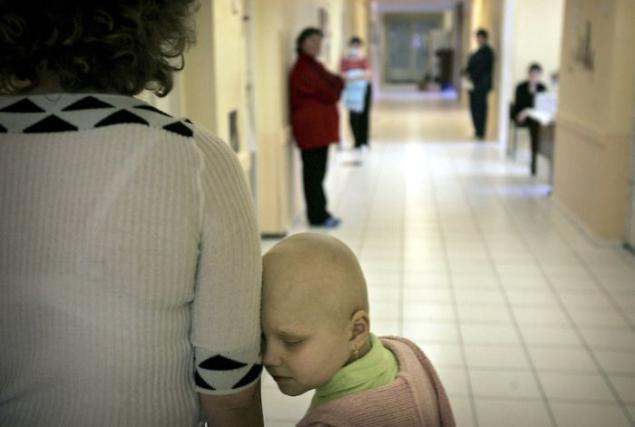
Tuesday, April 18, 2006.

Engineer studying the fracture in the control room reactor at the Chernobyl nuclear power plant, 13 October 1986, on the Sunday after the incident on Friday fire, which destroyed the roof. This is the second accident occurred a year after the April 26, 1986 accident. Environmentalists demanded an immediate shutdown of the reactor and the closure of the station.

Four of the thirty cows died during a stop at a checkpoint in Pontebba on the Italian-Austrian border lie in freight cars in Pontebba, Italy, Tuesday, May 7, 1986. Cows were sent back to Poland after the check has revealed that the animals are victims of radiation contamination as a result of the accident at the Chernobyl nuclear power plant in the Soviet Union.

Soviet art May 9, 1986 in Kiev prepare the tank with a special solution for decontamination of people exposed to radiation, as well as their clothing and equipment after the accident at the Chernobyl nuclear power plant.

May 9, 1986, Friday. A graph showing the melting process of nuclear fuel. It is believed that molten fuel could hardly get into ground water, even under the condition that it has passed through the reactor floor. So according to US nuclear engineers.

This editorial Morning Edition four British newspapers that tell about the accident at the Chernobyl nuclear power plant in Ukraine, the Soviet Union.

Firefighters in protective suits wash machine from West Germany about Herleshausen on the border with East Germany, May 3, 1986, after this car came from Poland, so that was contaminated by radiation after the Chernobyl nuclear power plant.

April 29, 1986. Photo Chernobyl nuclear power plant made by satellite «Landsat 5". Water object in the center of the photo - a cooling pool.

Boxes with unsold fresh fruit and vegetables in the vegetable market in Milan, May 3, 1986. After the accident at the Chernobyl nuclear power plant in the Soviet Union health ministry has banned the use of raw milk and fruit. This prohibition has acted throughout Italy for two weeks as a precaution; Nevertheless, trucks with vegetables and fruits continued as usual to arrive in Milan, although markets were closed for visitors.

Dutch truck arrived from Eastern Europe wash decontamination solution fire after his arrival at Herleshausen on the border with East Germany, Friday, May 3, 1986. Just this day was made disinfection ten trucks. The rest were sent back.

Employees of the grocery market in Milan, the largest of all the product markets in Italy and one of the biggest in Europe, carried out the destruction of fresh fruits and vegetables, which arrived in Italy on Saturday, May 3, 1986, fear of radioactive contamination as a result of the accident at the Chernobyl nuclear power station in the Soviet Union. After the accident, the Ministry of Health has banned the use of raw milk and fruit.

May 5, 1986. Although the Ministry of Health officials in West Germany warned farmers about the need to keep the cattle in sheds locked after the accident at the Chernobyl nuclear power plant in the Soviet Union, many have ignored this warning. This cow from Mikelshtadt, West Germany may have undergone radiation pollution.

April 29, 1986. Experts say that the radioactive cloud after the accident at the Chernobyl nuclear power plant in the Soviet Union, it is possible to reach the Arctic Circle, will be held over Canada and the northwestern United States. However, as stated, the radiation dose is too small to cause serious harm to human health.

Young people from West Berlin pours milk from cartons May 11, 1986 to protest against the possible radioactive contamination of milk and other food products. Increasing the level of radiation in food was observed in Berlin after the accident at the Chernobyl nuclear power plant in the Soviet Union. The inscription on the banner reads: "may cause poisoning».

Iodine solution was used as a possible resistance to radiation contamination. The nurse enters his three year old girl is holding her mother, the child health clinic in Warsaw, April 30, 1986.

Wednesday, May 1, 1986. 64 passengers arrived on board a special flight Austrian Airlines from Minsk, Soviet Union. All they have to pass control of the level of radiation exposure, barely leaving the plane at the airport in Vienna. Most of the passengers were relatives of the Austrians, who worked in the Soviet Union, however, journalists claimed that among them were 20 Germans.

May 7, 1986. Under the sign warning about radiation, scavenger in West Berlin puts boxes with fruits and vegetables that may have been infected. After the accident, the Ministry of Health has banned the use of raw milk and fruit.


Iodine solution as a possible counter radiation pollution, introduced three year old girl is holding her mother, the child health clinic in Warsaw, April 30, 1986.

Vienna, Austria, August 25, 1996. Nuclear experts from the International Agency for the control of atomic energy at the opening of the five-day meeting on the accident at the Chernobyl nuclear power plant in the Soviet Union. The photograph - Chernobyl Nuclear and firefighters at work.

Picture of the collapsed roof of the Chernobyl nuclear damaged in a fire. Russian television broadcast on October 12, 1991, Moscow. The fire occurred on the eve of Friday.

Check for radioactive contamination of water, typed in the creek near Kiev, May 9, 1986.. Checks were carried out every hour after the accident at the Chernobyl nuclear power plant in the Soviet Union.

1986. Aerial view of the Chernobyl nuclear power plant in the Soviet Union. Clearly visible destruction caused by the explosion of the fourth reactor April 26, 1986, as a result of which there was a release of radioactive material into the atmosphere. Ten years after the accident, the station still continued its work due to the acute shortage of electricity in Ukraine.

The photo was taken from a helicopter. Aerial view of the Chernobyl nuclear power plant, in particular, on the fourth unit, the explosion which occurred April 26, 1986. The fire lasted for 10 days, underwent radiation pollution Russia, Ukraine and Belarus. Promulgated in September Report of the International Health Organization announced that killed 4,000 people as a result of the accident, when in fact it is a much greater sacrifices. Ukraine claims that health problems after the accident began at 2, 4 million of its citizens, including 428,000 children have

Cuban President Fidel Castro (left) takes a group of children from Belarus after the Chernobyl nuclear power plant at the international airport of Havana, July 2, 1990.

Photo from the February issue of the Soviet magazine «Life», where - the first unit of the Chernobyl nuclear power plant. The photo was taken April 29, 1986. The Soviet government recognized that the station suffered in the accident, but the details were not specified.

Part of the collapsed roof of the Chernobyl nuclear power plant, which suffered a fire. The photo was taken on Friday 13th October 1991, during a visit by members of the media on the subject. On Sunday, the station has been reactivated.

Worker puts printing on animal carcasses in a slaughterhouse in Frankfurt in West Germany, May 12, 1986, in a sign that the meat is fit for consumption and not contaminated with radiation. After the accident at the Chernobyl nuclear power plant was subjected to a similar check all the meat.

April 1986, a few days after the accident. Aerial view of the Chernobyl nuclear power plant.

May 9, 1986. Kiev residents tested for radioactive contamination after the accident at the Chernobyl nuclear power plant.

1992. Abandoned due to radioactive contamination village in the Gomel region.

The population living near the Chernobyl nuclear station, check the level of radioactive contamination near Kiev on the farm Kopelovo, May 11, 1986. The photo was taken foreign photographers during the visit, which was organized for the foreign media, the Soviet government to demonstrate how to solve the problem arose.

Bremen, northern Germany, February 6, 1987. Activists put the seal on cars with contaminated milk powder. Milk came to Bremen to be sent to Egypt. It was produced after the accident at the Chernobyl nuclear power plant.

A few days have passed since the explosion of the fourth reactor. Swedish farmer in a protective suit destroys fodder, have been subjected to radiation contamination due to the accident at the Chernobyl nuclear power plant.

May 5, 1986, Wiesbaden. The boy looks at the locked gate attached to the children's playground classified "site is closed." All playgrounds have been closed by the decision of the city council a week after the accident at the Chernobyl nuclear power plant as a result of raising the level of radioactive contamination from 124 to 280 becquerels.

Chairman of the Presidium of the Supreme Soviet of the USSR Mikhail Gorbachev (center) and his wife Raisa Gorbachev (second from left) talking with officials at the Chernobyl nuclear power station February 23, 1989, during his first visit to the crash site.

Having undergone radiation contamination during the liquidation of the accident at the Chernobyl nuclear power plant equipment, vehicles and helicopters are in the open air near the village of Staff, January 31, 2006. During the period from April 27 to May 5, more than 30 military helicopters took part in extinguishing the fire in the reactor. Total for suppression was used 2,400 tons of lead and 1,800 tons of sand. Tanks, helicopters and all the equipment, is run by the army of the Soviet Union and participated in extinguishing the fire, was left in the open air.

Children's Hospital in Kiev, Tuesday, April 18, 2006. Ukrainian doctor takes blood from a seven-year Mary Burlak, a cancer patient. According to the organization «Greenpeace» more 90,000 people died of cancer due to the accident at the Chernobyl nuclear power plant, contrary to the UN report, where the number of alleged victims is 4000. For detailed information on the health effects of the most serious accident of the twentieth century are still unavailable, although since disaster has passed twenty years.

Collapsed beams and shattered concrete pillars inside the sarcophagus over the fourth reactor of the Chernobyl nuclear power plant November 10, 2000. Geiger counter detects radiation levels inside the sarcophagus of 80,000 micro-roentgen per hour, 16,000 exceed natural levels.

Doll and mask covered with radioactive dust in an abandoned kindergarten in the ghost town of Pripyat, 10 March 2006, Ukraine. Pripyat town, located near the Chernobyl nuclear power station was built for the workstation. All the residents were evacuated for several hours after the accident, which occurred April 26, 1986. For two months after the accident, 29 people have died from the number of workers who took part in its liquidation.

Photo by April 14, 1998. Control panel in the destroyed fourth block. 20 years since the disaster, which affected millions of people and the elimination of which went astronomical sums.

Measurement of radiation levels in the Belarusian village hoop on the territory of the 30 kilometer exclusion zone around the Chernobyl nuclear power plant. The fourth part of the territory of Belarus have been infected, and tens of thousands of people were evacuated in 1986 after an accident.

Ivan Kalenda wipes tears, visiting his three year old son Vitya, right, in oncological pediatric hospital in Gomel, 300 km south-west of Minsk, Belarus, March 19, 1996.

Covered with radioactive dust portraits of Soviet statesmen at the club in the ghost town of Pripyat, April 10, 2006. Portraits prepared for the May Day demonstration.

Dark transitions in the sarcophagus over the fourth power of the Chernobyl nuclear power plant.

Seattle, Tuesday, Aug. 27, 1996. Eight-year Olga Osterozha of harmony, Belarus, choose a hairstyle in hairdressing album before transplanting hair follicles, which is part of the program of assistance to children affected by the accident at the Chernobyl nuclear power plant. Olga lost hair in the age of four. Olga and her sister Tanya, who eleven years old, living in a foster home near Seattle.

Eight-year Olga Osterozha of harmony, Belarus, watches as her sister implanted hair Tanya.

April 17, 2006. The patient at the Institute of Endocrinology, reanimation. The patient has gone through surgery for thyroid cancer. Thyroid cancer in Ukraine officially recognized consequence of the accident at the Chernobyl nuclear power plant.

March 30, 2006. Abandoned house in the village ghost Redkovka 35 kilometers from the Chernobyl nuclear power plant. Despite the fact that most of the residents were evacuated after the accident at the Chernobyl nuclear power plant, some prefer to return to their old homes, explaining that they can not adapt to life in a new place.

March 11, 1996. Professor of biological sciences Vyacheslav Konovalov, shows a stuffed mule mutant in his laboratory in Zhytomyr, about 120 kilometers west of Kiev. He collects the exposure of stuffed animals and plants-mutants. Professor - weirdo and has a lead protective apron under her clothes since the accident.

Seven Years Maria Bourlak with cancer in pediatric oncology hospital in Kiev, April 18, 2006.

The fourth reactor of the Chernobyl nuclear power plant. Cured foam, lead and boron powder that helicopters dropping, trying to prevent a nuclear reaction. In the construction of the sarcophagus hastily radiation level reaches thousands of X-rays, and a deadly level - for 150 X-rays.

Tuesday, April 23, 1996. A woman looks at a fire in a small village town red ten kilometers from the Chernobyl nuclear power plant. Fire in five villages lasted seven hours and the atmosphere was thrown a huge amount of toxic substances.

April 10, 2006. Constructors in protective masks and suits working to strengthen the crumbling sarcophagus over the fourth reactor of the Chernobyl nuclear power plant. Due to high levels of radiation workers work in shifts, and the change may last from four to fifteen minutes.

Surgery for thyroid cancer in the hospital Kiev, April 6, 2006. The incidence has increased rapidly since the accident at the Chernobyl nuclear power plant.

Pripyat, Ukraine, July 1988. Observation instrument readings, controlling operation of the reactor. In 1988, a reactor exploded and killed at least 31 people.

Toys and masks covered with radioactive dust in kindergarten in the ghost town of Pripyat, 10 March 2006.

Pupils in gas masks during a lesson pre-conscription training in Rudo near the exclusion zone around the Chernobyl nuclear power plant, Monday, April 3, 2006.

November 10, 2000. Contaminated equipment far from Chernobyl.

Saturday, February 18, 2006. Ivan and Elena Muzichenko for home use kerosene lamp - electricity in the village Bartolomeevka, located 330 km south-east of Minsk, no. Twenty years after the accident at the Chernobyl nuclear power plant in many abandoned villages in Belarus residents have returned - the government issued a decree that the black soil should not be left untreated, while the storm radiation contamination allegedly was artificially inflated.

April 14, 1998. The workers of the Chernobyl nuclear power station pass by the control panel of the destroyed fourth block.

Bedroom in a kindergarten ghost town of Pripyat, 27 February 2006.

Children ride in a ghost town of Pripyat, photo taken May 26, 2003. All the city had 45,000 residents who were evacuated in the first three days after the accident at the Chernobyl nuclear power plant.

Tuesday, April 18, 2006.



